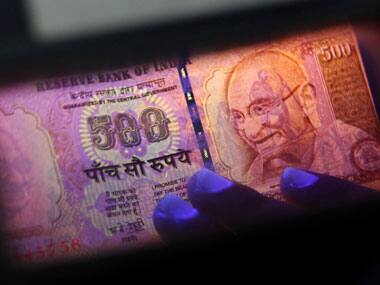The negatives of a current account deficit, weak capital flows, slowing growth and inflation are not going to go away in a hurry. The rupee, when it was at levels of 44 to the dollar, was seen to be strengthening despite inherent flaws in the country’s economy, and now, at levels of 51 to the dollar, is seen to be weakening despite positives in the economy.
The dollar tanked from 44 per dollar as the market realised the negatives in the economy, and in the same way, it will rally from levels of around 51 against the dollar as the market realises the positives.
[caption id=“attachment_134609” align=“alignleft” width=“380” caption=“It will rally from levels of around 51 against the dollar as the market realises the positives. AFP”]
 [/caption]
[/caption]
The rupee is experiencing huge negative sentiment, with talks of further downside to the currency. The rupee has depreciated 15.7 percent against the dollar since 1 August till date, the worst performer in relation to its counterparts.
The Brazilian real (BRL) and the Russian eouble (RUB) followed the rupee in poor performance with losses of 13.9 percent and 11.2 percent in the same period, respectively.
Surprisingly, the euro, which is seen as the cause of the problems leading to risk aversion, has fallen only 5.5 percent against the dollar in the same period.
The performance of the dollar since 21 September until date is even more striking.The rupee has fallen 4.6 percent over the period, while other emerging currencies including the real, rouble and South Korean won (KRW) have actually gained against the dollar.
The stark underperformance of the rupee since the third week of September against its peers is giving rise to questions of India’s fundamentals. Markets are now talking about further weakness in the rupee due to worries on the current account, weak capital flows, falling growth and untamed inflation.
See the movement of world currencies below
[caption id=“attachment_134604” align=“alignleft” width=“600” caption=“Table”]
 [/caption]
[/caption]
The question is, are all the negatives built in to the price of the rupee at 51 to the dollar or is there more pain for the local currency? The answer: all the negatives are built in to the current value of the rupee and the currency should look to trend up from here as markets weed out the negatives and look for positives that are still out there.
Deficit fears overblown?
India’s trade deficit at $19.6 billion for October was the highest on record.The trade deficit for April-October was $93.7 billion against a deficit of $102 billion seen in the same period last year. If the trade deficit continues to trend higher, the current account deficit could cross 3 percent of GDP in 2011-12 from levels of 2.6 percent in 2010-11.
However, a weak rupee helps exports of goods and services, which could trend higher and help the current account in coming months.
On the capital flow side, foreign institutional investors (FIIs) have actually been net buyers of equity and debt in October and November till date, with net purchases of $700 million in equity and $350 million in debt.
The recent increase in the FII debt limit by $5 billion each in Indian government and corporate bonds could see further debt inflows. Government and corporate bond limits of $10 billion and $15 billion have been almost exhausted, with utilisation rates of over 90 percent, and there is demand from FIIs who have not invested due to limit issues.
India’s growth rate is expected to come in below the Reserve Bank of India’s estimate of 7.6 percent due to issues of global growth as well as issues of interest rates and inflation on the domestic front.
However, even at less than 7.6 percent GDP growth for 2011-12, India will be one of the fastest-growing countries in the world.
India’s headline inflation came in at 9.7 percent in October. It is the sixth straight month that inflation has stayed above 9 percent, and is making the RBI maintain its tight monetary policy stance. The RBI, which has raised benchmark rates by 375 basis points (100 basis points = 1 percentage point) over the past 20 months, has indicated that rates are close to peaking out.
If the global economy continues to falter on eurozone debt issues, inflation is likely to come off down the line, allowing the RBI to ease up on policy.
Arjun Parthasarathy is the editor of www.investorsareidiots.com , a web site for investors.
Arjun Parthasarathy has spent 20 years in the financial markets, having worked with Indian and multinational organisations. His last job was as head of fixed income at a mutual fund. An MBA from the University of Hull, he has managed portfolios independently and is currently the editor of www.investorsareidiots.com </a>. The website is for investors who want to invest in the right financial products at the right time.
)